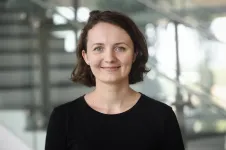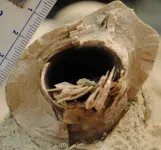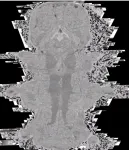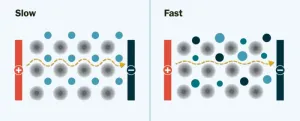(Press-News.org) By Alistair Jones
SMU Office of Research & Tech Transfer – The life of a researcher is not for everyone, but for Yuliya Dzyuban, a Research Fellow in the new College of Integrative Studies at Singapore Management University (SMU), it's a perfect fit.
“With time, I realised that studying is what I do best and enjoy the most. Research offers opportunities for endless learning,” she says.
“There are always new projects, new challenges, new ideas and evolving methods. I love the fact that I can learn something new at work every day, be it reading a scientific paper, developing a method, or mastering a new tool.”
Dzyuban began her studies with a degree in architecture in her native Ukraine before her academic career was boosted by a Fulbright Scholarship.
“The scholarship opened a world of possibilities for me,” she says. “First, it gave me an opportunity to obtain a master’s degree in sustainability in a US university, which would have been impossible for me otherwise for several reasons. Coming from an economically disadvantaged country, I could not afford studying abroad. [And] a degree in sustainability was not offered in my home country at the time.
“The Fulbright Scholarship exposed me to a community of brilliant scholars and inspiring individuals from all over the world. It widened my network, which helped me in my further professional development.”
That professional development was again boosted recently when Dzyuban was awarded one of the inaugural 2022 SMU Research Staff Excellence Awards for her work within the Cooling Singapore (CS) team — a multi-disciplinary research project dedicated to developing solutions to address the urban heat challenge in Singapore.
Smart urban design
Supported by National Research Foundation Singapore, the CS project began in 2017 and has moved through two stages to reach the present CS 2.0.
“I joined SMU to work for CS 1.5 and carried on for 2.0. All my work is done under the umbrella of the project,” Dzyuban says.
“I explore how differences in the urban environment – such as, the configuration of urban form and presence of vegetation – influence people’s perceptions of heat, behaviour and health. To do that, I design and execute research projects, analyse data, and synthesise and disseminate results through various scientific and non-scientific mediums.”
One of Dzyuban's projects, which caught the attention of the Excellence Awards evaluation committee, is a heat walk method.
“Heat walk, or thermal walk, is a relatively new method that is used in thermal comfort studies to get a better understanding of how pedestrians feel while walking outdoors. I use it to expand the knowledge of how variations in urban form and presence of vegetation influence health and perceptions of heat of pedestrians,” she says.
“To do that, urban residents are asked to walk along a defined route in the city and answer questions in relation to their thermal state. In addition, they wear wrist sensors that measure pulse rate and skin temperature, which allows us to understand the connections between their thermal experiences and body responses.
“Simultaneously, we measure microclimate variables, [and the use of] a mixed-methods approach, combining human perceptions, health and microclimate data, allows us to get a deeper understanding of how to design more comfortable cities,” Dzyuban says.
Thermal perceptions
Another of Dzyuban's noted projects looked at the use of social media to report perceptions of thermal comfort and discomfort when the weather changes.
“For this project we used seven years of weather data for Singapore and Phoenix (in the US), together with Twitter data to explore whether social media can be used for assessment of thermal comfort of residents,” she says.
“We filtered the tweets that included the word ‘weather’, and then classified them into thermal comfort sensations as hot and cold. We found that even though there is only a 3°C average difference in air temperature for Singapore annually, residents were highly sensitive to hotter months.
“In other words, there were many more tweets cursing and complaining about how hot it was. This showed that social media can be an effective tool to gauge public thermal perceptions. Future work could include the usage of geotagged social media data, then we could potentially identify the most uncomfortable areas in the city for more targeted interventions.”
And why is the perception of heat, rather than just temperature and humidity data, so pertinent to CS 2.0?
“Temperature and humidity do not allow a full understanding of how an individual would feel outdoors,” Dzyuban says.
“For example, the amount of solar radiation a person is exposed to, being in the sun or shade, is the most influential thermal comfort parameter in a climate such as Singapore's.
“To account for that we use more complex thermal comfort indices, which allow us to estimate the compound effect of air temperature, wind speed, solar radiation and atmospheric moisture on the thermal comfort of a person. Such an index is integrated as one of the outputs in DUCT.”
Decision support system
The creation of DUCT – or Digital Urban Climate Twin – is the ultimate goal of the CS project.
“DUCT is essentially a federation of models with an online user-friendly interface which allows experimenting with various development scenarios to assess their impact on microclimate and thermal comfort,” Dzyuban says.
“For instance, interested parties will be able to see the differences in microclimate between different shapes and types of neighbourhood parks, differences in building form and height, as well as scenarios related to the implementation of centralised cooling systems and vehicle electrification. It is developed in partnership with Singapore agencies for their future use to assist in science-informed, long-term planning.”
Dzyuban says CS 2.0 is in the final development stage.
“We are finalising data collection, modelling, analysis and scenario development. The CS 2.0 team is working on integrating all the models into a comprehensive decision support system (DUCT) which eventually will be available for use by government agencies and other selected stakeholders.”
And what will come next after CS 2.0 for this dedicated researcher?
“I want to continue my work on developing heat mitigation strategies for cities. I have experience working on projects for some of the hottest cities in the world, such as Phoenix in the US, Hermosillo in Mexico, and now Singapore. They are also very different in their approach to governance and implementation of solutions. I am looking forward to expanding my international collaborations to other locations where my experience can be useful,” Dzyuban says.
END
Mitigating heat impacts for cooler cities
2023-02-24
ELSE PRESS RELEASES FROM THIS DATE:
Realizing synergy for bots and engineers
2023-02-24
By Alistair Jones
SMU Office of Research & Tech Transfer – Despite hero moments in movies where fingers clatter at dizzying speed across computer keyboards, not everyone in the real world finds code fascinating, nor algorithms intriguing.
In fact, there is a worldwide shortage of skilled data scientists and software engineers.
David Lo, a Professor of Computer Science at Singapore Management University (SMU), suggests two reasons for the shortfall.
“First, software today is everywhere; organisations, companies, governments ...
How the close dinosaurian relatives of birds evolved gigantic and miniature sizes
2023-02-23
An analysis of fossils of non-avialan theropod dinosaurs – a dinosaur clade that includes an array of body sizes – has provided findings that run contrary to expectations regarding the factors that inform the evolution of body size diversity. “Once quantified and analyzed in a phylogenetic framework [like this], we predict that diverse growth strategies will be recognized in other clades,” say the study’s authors. Over evolutionary history, many taxa have evolved very large and very small body sizes, and even closely related species can exhibit widely disparate sizes. ...
How does a person’s ethnicity impact their risk of death?
2023-02-23
In the UK, disparities in mortality risk factors exist between ethnic groups, with differences in overall mortality, top causes of mortality and individual mortality risk factors, according to a new study published this week in the open-access journal PLOS Global Public Health by I. King Jordan of Georgia Institute of Technology, US, and colleagues.
Despite the progress made in improving mortality rate, life expectancy, and disease survival outcomes in the last century, health disparities between various population ...
Plastic upcycling to close the carbon cycle
2023-02-23
RICHLAND, Wash.—There’s a lot of potentially useful raw materials bound up in used face masks, grocery bags and food wrap. But it has been much cheaper to keep making more of these single-use plastics than to recover and recycle them.
Now, an international research team led by the Department of Energy’s Pacific Northwest National Laboratory has cracked the code that stymied previous attempts to break down these persistent plastics. They reported their discovery in today’s issue of Science.
Low temperature and reaction control
Typically, recycling plastics requires ‘cracking’ or ...
Evolution of dinosaur body size through different developmental mechanisms
2023-02-23
The meat-eating dinosaurs known as theropods that roamed the ancient Earth ranged in size from the bus-sized T. rex to the smaller, dog-sized Velociraptor. Scientists puzzling over how such wildly different dinosaur sizes evolved recently found – to their surprise– that smaller and larger theropod dinosaurs like these didn’t necessarily get that way merely by growing slower or faster.
In a new paper published in Science, “Developmental strategies underlying gigantism and miniaturization ...
MoBIE enables modern microscopy with massive data sets
2023-02-23
High-resolution microscopy techniques, for example electron microscopy or super-resolution microscopy, produce huge amounts of data. The visualization, analysis and dissemination of such large imaging data sets poses significant challenges. Now, these tasks can be carried out using MoBIE, which stands for Multimodal Big Image Data Exploration, a new user-friendly, freely available tool developed by researchers from the University of Göttingen and EMBL Heidelberg. This means that researchers such as biologists, who rely ...
$3M NIH grant will fund next steps of research on dance and brain health
2023-02-23
WINSTON-SALEM, N.C. – Feb. 23, 2023 – Wake Forest University and Wake Forest University School of Medicine will receive $3 million over five years from the National Institutes of Health (NIH) to help researchers take the next steps in nearly a decade of research that indicates dance can promote cognitive health.
The grant funds a new study called IGROOVE that will help researchers determine what kinds of dance, the frequency of the dance classes and what aspects of the dance class – music, social interaction, cognitive challenge – affect fitness, memory and brain health.
The research will be co-led by Christina ...
UC Irvine researchers create E. coli-based water monitoring technology
2023-02-23
Irvine, Calif., Feb. 23, 2023 – People often associate Escherichia coli with contaminated food, but E. coli has long been a workhorse in biotechnology. Scientists at the University of California, Irvine have demonstrated that the bacterium has further value as part of a system to detect heavy metal contamination in water.
E. coli exhibit a biochemical response in the presence of metal ions, a slight change that researchers were able to observe with chemically assembled gold nanoparticle optical sensors. Through a machine-learning ...
New $2.9 million grant helps researchers address food insecurity for Hoosiers
2023-02-23
INDIANAPOLIS—With a $2.9 million grant from the National Institute on Minority Health and Health Disparities, researchers from Indiana University School of Medicine are working to improve food insecurity in Indiana and ultimately improve the health of people in Indiana.
Individuals who experience food insecurity–inconsistent access to affordable and nutritious food–are more susceptible to a variety of health conditions, including hypertension and Type 2 Diabetes. The FoRKS: Food Resources ...
On the road to better solid-state batteries
2023-02-23
A team from Lawrence Berkeley National Laboratory (Berkeley Lab) and Florida State University has designed a new blueprint for solid-state batteries that are less dependent on specific chemical elements, particularly critical metals that are challenging to source due to supply chain issues. Their work, reported recently in the journal Science, could advance solid-state batteries that are efficient and affordable.
Touted for their high energy density and superior safety, solid-state batteries could be a game-changer for the electric car industry. ...







